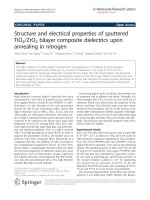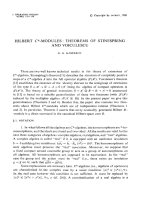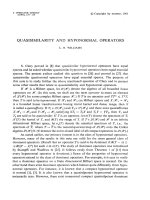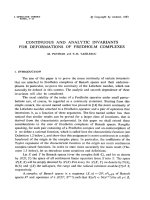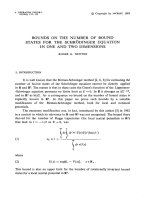Báo cáo toán học: "Graphic and Protographic Lists of Integers" docx
Bạn đang xem bản rút gọn của tài liệu. Xem và tải ngay bản đầy đủ của tài liệu tại đây (92.44 KB, 6 trang )
Graphic and Protographic Lists of Integers
Dmitry Fon-Der-Flaass
∗
Institute of Mathematics
Novosibirsk State University, Novosibirsk, Russia
Douglas B. West
†
Department of Mathematics
University of Illinois, Urbana, IL 61801
Submitted: May 19, 2003; Accepted: Dec 21, 2003; Published: Jan 2, 2004
MR Subject Classifications: 05C07
Abstract
A positive list (list of positive integers) is protographic if its merger with all but
finitely many positive graphic lists is graphic. Define the family P
s
of s-protogaphic
lists by letting P
0
be the family of positive graphic lists and letting P
s
for s>0be
the family of positive lists whose merger with all but finitely many lists in P
s−1
is
in P
s−1
.
ThemainresultisthatX ∈P
s
if and only if t(X) ∈P
s−1
,wheret(X)isthe
list obtained from X by subtracting one from each term of X (deleting those that
become 0) and appending a 1 for each term of X. A corollary is that the maximum
number of iterations to reach a graphic list from an n-term even list with sum 2k is
k−n+1 (when k ≥ n), achieved by the unique such list having one term larger than 1.
1 Introduction
An integer list of length n is an n-tuple of integers. A graphic list is a list whose entries
are the degrees of the vertices in a simple graph. Whether a list is graphic is determined
by the multiset of entries; the order of the entries is irrelevant. Because entries equal to 0
∗
This work partially supported by RFFI grants 03-01-00796 and 02-01-00039 and by grant No.6 of the
6th Expertise of Young Scientists’ Project of RAN.
†
This material is based upon work supported by NSA under Award No. MDA904-03-1-0037, which
requires the disclaimer that any opinions, findings, and conclusions or recommendations expressed in this
publication are those of the author(s) and do not necessarily reflect the views of the NSA.
the electronic journal of combinatorics 11 (2004), #R4 1
do not affect whether a list is graphic, we consider only lists of positive integers. (We use
“list” rather than “sequence” since a sequence is a function whose domain is infinite.)
Many characterizations of graphic lists are known: Sierksma and Hoogeveen [6] state
seven. A well-known explicit characterization due to Erd˝os and Gallai [2] is that, when
the entries d
1
, ,d
n
are written in nonincreasing order, the inequalities
k
i=1
d
i
≤ k(k +
1) +
n
i=k+1
min{k, d
i
} hold for every k (see Aigner and Triesch [1] for an elegant proof).
This note introduces a measure of how far a list is from being graphic. Let a positive
list X be protographic if there are only finitely many positive graphic lists Y such that
the merger X ∪ Y is not graphic, where the merger of two lists is obtained by summing
the multiplicities of their elements.
More generally, define a sequence of families of lists recursively as follows. Let P
0
be
the set of positive graphic lists. For s>0, let P
s
be the set of positive lists X such that
X ∪ Y ∈P
s−1
for all but finitely many Y ∈P
s−1
. The lists in P
s
are the s-protographic
lists. Thus the positive graphic lists are the 0-protographic lists, and the protographic
lists are the 1-protographic lists.
As might be expected, every s-protographic list is also (s + 1)-protographic. This
follows from the fact that X ∪ Y ∈P
s
when X ∈P
s
and Y ∈P
s
. To see this latter fact,
write (X ∪ Y ) ∪ Z as X ∪ (Y ∪ Z) for Z ∈P
s−1
.WehaveY ∪ Z ∈P
s−1
for all but finitely
many such Z. Excluding the finitely many Z such that Y ∪ Z/∈P
s−1
and the finitely
many Z such that Y ∪Z ∈P
s−1
but X ∪(Y ∪Z) /∈P
s−1
,wehavethat(X ∪Y )∪Z ∈P
s−1
for all but finitely many Z ∈P
s−1
.
We use max(X) for the largest entry and (X) for the length (number of terms) of
a list X. Our main result is the characterization of s-protographic lists using a special
operation on lists. Let t(X) denote the list obtained from X by subtracting 1 from each
element of X (discarding terms that reach 0) and then appending (X) entries equal to 1.
We prove that X is protographic if and only if t(X) is graphic. This serves as the
basis step for an induction to prove the characterization in general:
Theorem 1 If X is a positive list of integers, and s is a positive integer, then X ∈P
s
if
and only if t(X) ∈P
s−1
.
The definition implies inductively that only lists with even sum can be s-protographic.
We define an even list to be a positive list with even sum. An even list with all entries
equal to 1 is graphic. Since max(t(X)) = max(X) − 1whenmax(X) > 1, our theorem
thus proves inductively that every list with even sum belongs to P
s
for some s.
For an even list X, we define the non-graphicality γ(X) to be the minimum s such that
X ∈P
s
. A corollary of our theorem shows that the maximum non-graphicality among
even lists with sum 2k is k, achieved by the list consisting of a single term equal to 2k.
More generally, the maximum non-graphicality among n-term even lists with sum 2k is
k − n +1(when k>n− 1), achieved by the unique such list having one term larger
than 1. The non-graphicality of n-term lists with unbounded sum is unbounded.
the electronic journal of combinatorics 11 (2004), #R4 2
2 The Proofs
Let n(G) denote the number of vertices of a graph G.Theboundary ∂S of a set S of
vertices in a graph G is the set of vertices outside S whose neighborhoods intersect S.A
dominating set for G is a set S ⊆ V (G) such that ∂S = V (G) − S. Ore [5] observed that
every graph G without isolated vertices has a dominating set of size at most n(G)/2. A
simple proof is that for every minimal dominating set, the remaining vertices also form a
dominating set.
Lemma 2 If G is a simple graph without isolated vertices such that |∂S| <kfor all
S ⊆ V (G), then n(G) ≤ 2k − 2.
Proof. Let S be a smallest dominating set of G. By Ore’s observation [5], n(G)=
|S| + |∂S|≤n(G)/2+k − 1. Thus n(G) ≤ 2k − 2.
A list X with max(X) ≥ (X) is not graphic. The Havel–Hakimi Theorem ([3, 4])
states that a positive list X is graphic if and only if the list obtained from X by deleting the
element max(X) and subtracting 1 from max(X) of the next largest elements is graphic.
Let X
denote the positive list obtained from a list X by doing this and also dropping
any elements that thus become 0. We use 1
k
to denote k entries equal to 1.
We will need an operation on simple graphs that also is used in inductive proofs of the
Havel–Hakimi Theorem. Given vertices w, x, y, z in a simple graph G such wx, yz ∈ E(G)
and xy, wz /∈ E(G), the operation of deleting wx, yz and adding xy, wz to E(G)isa
2-switch; it produces another simple graph with the same vertex degrees.
Theorem 3 When X is a positive list, X ∈P
1
if and only if t(X) is graphic.
Proof. Let k = (X).
Necessity. Let Y
n
be the degree list of the star with n leaves. By the definition of
P
1
, the list X ∪ Y
n
is graphic for sufficiently large n,sayn>n
0
.Taken such that
n>max{n
0
, max(X),k}. By the Havel–Hakimi Theorem, (X ∪ Y
n
)
is graphic. Since
n =max(X ∪ Y
n
), and the next k largest elements are those of X,andn>k,wehave
(X ∪ Y
n
)
=(x
1
− 1, ,x
k
− 1, 1
k
)=t(X) (discarding terms such that x
i
− 1=0).
Sufficiency. Assume that t(X) is graphic. We claim that if Y is a positive graphic list
of length at least 2k − 1, then X ∪ Y is graphic. Since there are finitely many graphic
lists of length at most 2k − 2, this will yield X ∈P
1
.
Among all graphs with degree list t(X), choose one whose set of vertices of degree 1
induces the fewest edges. Let H be the graph with 2k vertices obtained from it by adding
an isolated vertex for each 1 in X.Letw
1
, ,w
k
be k vertices of degree 1 in H that
induce the fewest edges among all sets of k vertices of degree 1. The remaining vertices are
u
1
, ,u
k
, indexed so that d
H
(u
i
)=x
i
− 1 (this includes all the added isolated vertices).
Let W = {w
1
, ,w
k
} and U = {u
1
, ,u
k
}. We reduce the problem to the case
where W is an independent set in H.IfW induces an edge, then its endpoints have
degree 1, so if there is an edge induced by U we can perform a 2-switch to reduce the
the electronic journal of combinatorics 11 (2004), #R4 3
number of edges within W . Hence if W induces an edge, then we may assume that U is
an independent set in H.Now
d
H
(u
i
) <k, because the only edges incident to U are
also incident to W , and fewer than k such edges are incident to W .
Thus X consists of k positive numbers summing to k + j,wherej<k.Inthiscase
we show that X is graphic, by induction on k. If all entries are 1, then X is realized by a
matching. Otherwise, the pigeonhole principle implies that X contains a 1. Form X
by
deleting this 1 and subtracting 1 from some larger element of X.NowX
has length k −1
and sum k − 1+j − 1, with j − 1 <k− 1. By the induction hypothesis, X
is graphic,
and we add a pendant edge to a realization of it to obtain a realization of X. Since every
s-protographic list is (s + 1)-protographic, this yields X ∈ P
1
.
Hence we may assume that W is an independent set in H.NowletG be a graph
with degree list Y . By Lemma 2, there exists S ⊆ V (G)with|∂S|≥k; give the names
w
1
, ,w
k
to distinct vertices in ∂S.Letz
1
, ,z
j
(not necessarily distinct) be vertices
of S such that z
i
w
i
∈ E(G) for each i.
Because W is an independent set in H, the union G∪H is a simple graph with k+(Y )
vertices. In G ∪ H, replace the edge z
i
w
i
with the edge z
i
u
i
for 1 ≤ i ≤ j. This increases
the degree of u
i
to x
i
and decreases the degree of w
i
to d
G
(w
i
). Hence the modified graph
F is a simple graph with degree list X ∪ Y .
Let B
s,n
denote the list of length n consisting of one entry equal to n − 1+2s and
n − 1 entries equal to 1. Note that B
0,n
is the degree list of a star with n vertices.
By construction, it is immediate that t(B
s,n
)=B
s−1,n+1
. The proof of the main result
(Theorem 1) involves a statement about B
s,n
equivalent to the other two.
The application of 2-switches in the proof of the Havel–Hakimi Theorem is a statement
that we will need here: for every graphic list X, there is a simple graph G whose degree
list is X in which a vertex of highest degree is adjacent only to vertices of the highest
degrees among the remaining vertices. If w has maximum degree, and w is adjacent to
z but not to x among the highest-degree vertices, then there exists y ∈ N(x) − N(z)
since d(x) ≥ d(z), and the 2-switch that replaces wz and xy with wx and zy reduces the
number of missing desired neighbors of w.
Theorem 4 For a positive list X and nonnegative integer s, the following are equivalent:
A) X ∈P
s+1
;
B) X ∪ B
s,n
∈P
s
for sufficiently large n;
C) t(X) ∈P
s
.
Furthermore, B
s+1,n
∈P
s+1
, and there are finitely many lists in P
s+1
of a given length.
Proof. We prove all claims simultaneously by induction on s. Theorem 3 states the
equivalence of A and C for s = 0. The definition of P
1
yields A ⇒ B for s =0. Notethat
B
1,n
∈P
1
, because t(B
1,n
)=B
0,n+1
∈P
0
. For every X ∈P
1
of length k, the list t(X)has
length at most 2k. The finiteness of {X ∈P
1
: (X)=k} thus follows from the finiteness
of the set of graphic lists of length at most 2k.
To complete the basis step, it remains only to show B ⇒ Cwhens = 0. Choose some
n with n>(X) such that X ∪ B
0,n
is graphic. Note that n − 1 is the largest value in this
the electronic journal of combinatorics 11 (2004), #R4 4
list. Choose a graph G with degree list X ∪ B
0,n
such that the vertex w of degree n − 1
is adjacent to vertices of the next highest degrees, as in the proof of the Havel–Hakimi
Theorem. Now G − w has degree list t(X).
For the induction step, consider s>0.
A ⇒ B. This follows from the definition of P
s+1
, since part of the final statement of
the induction hypothesis is that B
s,n
∈P
s
for all n.
B ⇒ C. For sufficiently large n,wearegivenX ∪ B
s,n
∈P
s
. By the induction
hypothesis, t(X ∪ B
s,n
) ∈P
s−1
.Sincet(X ∪ Y )=t(X) ∪ t(Y ) for all X and Y ,wehave
t(X) ∪ t(B
s,n
) ∈P
s−1
.Thust(X) ∪ B
s−1,n+1
∈P
s−1
. Since this holds for sufficiently large
n, the induction hypothesis for B ⇒ A yields t(X) ∈P
s
.
C ⇒ A. Suppose that t(X) ∈P
s
. By the definition of P
s
, there exists n
0
such that
t(X) ∪ W ∈P
s−1
whenever W ∈P
s−1
and (W ) >n
0
.ConsiderZ = X ∪ Y for Y ∈P
s
with (Y ) >n
0
. From the final statement of the induction hypothesis, (Y ) >n
0
excludes
only finitely many candidates for Y from P
s
;thusX ∈P
s+1
will follow from Z ∈P
s
.
We have t(Z)=t(X) ∪ t(Y ). The induction hypothesis for A ⇒ C yields t(Y ) ∈P
s−1
.
Also, (t(Y )) ≥ (Y ) >n
0
. By the choice of n
0
, t(X) ∪ t(Y ) ∈P
s−1
, and hence t(Z) ∈
P
s−1
. Now the induction hypothesis for C ⇒ A implies Z ∈P
s
.
Finally, consider the last statement. We have t(B
s+1,n
)=B
s,n+1
, which by the in-
duction hypothesis for this statement belongs to P
s
. Since we have now proved C ⇒ A,
we conclude that B
s+1,n
∈P
s+1
. Also, A ⇒ C and the induction hypothesis for the last
statement implies that P
s+1
has finitely many lists of a given length.
Recall that the non-graphicality γ(X) of an even list X is the least s with X ∈P
s
.
Corollary 5 If X is an even list, then γ(X) ≤ max{0,
max(X)−(X)+1
2
}, with equality for
non-graphic lists only when X has only one element larger than 1. In particular, for
k ≥ n − 1 the non-graphicality among n-term lists with sum 2k is maximized only by the
unique list having just one entry larger than 1, where it equals k − n +1.
Proof. When X is graphic, max(X) ≤ (X) − 1, so the claim holds when γ(X)=0. We
proceed by induction on γ(X).
If X is not graphic, then max(X) > 1, and by Theorem 4 we have γ(X)=1+γ(t(X)).
Also max(t(X)) = max(X) − 1and(t(X)) ≥ (X) + 1, with equality only when X has
exactly one element larger than 1. By the induction hypothesis, γ(X) ≤ max{1, 1+
max(X)−1−((X)+1)
2
}, with equality only when X and t(X) each have exactly one element
larger than 1. Since X is not graphic, this implies that max(X) >(X) − 1, and hence
the desired bound and condition for equality follow.
When X has exactly one element larger than 1, the same is true of t(X) (unless the
largest element in X is 2), and by induction the bound on γ(X) holds with equality. In
this case max(X)=2k − n + 1, so the bound
max(X)−(X)+1
2
equals k − n +1.
the electronic journal of combinatorics 11 (2004), #R4 5
References
[1] M. Aigner and E. Triesch, Realizability and uniqueness in graphs, Discrete Math. 136
(1994), 3–20.
[2] P. Erd˝os and T. Gallai, Graphs with prescribed degrees of vertices, Mat. Lapok 11
(1960), 264–274.
[3] S. L. Hakimi, On realizability of a set of integers as degrees of the vertices of a linear
graph. J. Soc. Indust. Appl. Math. 10 (1962), 496–506.
[4] V. Havel, Eine Bemerkung ber die Existenz der endlichen Graphen.
ˇ
Casopis Pˇest.
Mat. 80 (1955), 477–480.
[5] O. Ore, Theory of graphs, Amer. Math. Soc. Colloq. Publ., Vol. XXXVIII, (Amer.
Math. Soc., 1962).
[6] G. Sierksma and H. Hoogeveen, Seven criteria for integer sequences being graphic. J.
Graph Theory 15 (1991), 223–231.
the electronic journal of combinatorics 11 (2004), #R4 6

